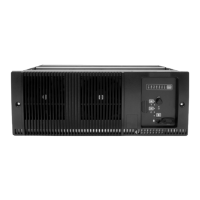44 Network Circuitry TB9100 Reciter Service Manual
© Tait Electronics Limited January 2006
Aside from the external interrupts, the interrupt controller also combines
and prioritizes interrupts from internal sources including the:
■ software watchdog timer
■ PCMCIA interface
■ communications processor (see “Interrupt Controller” on page 55)
PCMCIA Interface The MPC incorporates logic to control the interface to two PCMCIA card
sockets. This is not used in the ASIF but the pins (IP_A[0..7]), normally
used for sensing the PCMCIA card status, are used for sensing the general-
purpose digital inputs (see “Parallel Ports” on page 59 and “General-
purpose Digital Inputs” on page 72). These pins feature change-of-state
sensing, generating an interrupt on a change of pin state. This allows the
software to respond quickly to changes without the high overhead of
continuous polling.
5.2.3 RISC Reset and Configuration
MPC Reset The MPC supports several levels of resets that can be initiated internally to
the MPC or driven by external devices. The different levels of resets are
primarily used to enable software debugging without disturbing the internal
state of some parts of the MPC. In particular, a soft reset retains the major
MPC system configuration and maintains the memory controller refresh
operation (see “SDRAM Refresh Cycles” on page 64), so that the dynamic
memory contents are not lost.
The sources of reset used in the ASIF and their effects are detailed in
Tabl e 5 .2.
On power up the MPC’s PORESET
input is taken low by the power supply
circuitry (see “Power-on Reset” on page 85). In response, the MPC drives
its hard reset (HRESET
) and soft reset (SRESET) outputs low, resetting any
external circuitry connected to them.
Table 5.2 Reset Responses
Reset
source
PLL reset
System
config
reset
Clock
module
reset
HRESET
driven
Debug
port
config
Other
internal
logic
reset
SRESET
driven
Power-on
reset
YYYYYYY
Software
watchdog,
debug port
hard reset
NYYYYYY
Debug port
soft reset
NNNNYYY

